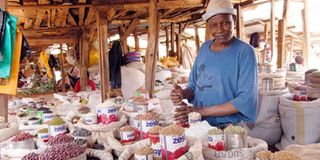Kenyan families feel pinch of rising food prices

PHOTO/FILE
Selling grain at the market. The poor are hit hardest by volatile food prices because they spend a much higher proportion of their income on food.
Xavier Nyongesa, 28, has three jobs to support his wife and nine month-old baby.
“I’m a consultant for an IT company, where I’m paid Sh30,000 a month; I also have a small start-up advertising firm that does billboards and brings in about Sh30,000,” he says.
“Finally, I’m a director of a company that does fitness and dance classes in Nairobi that pays about Sh15,000.”
Nyongesa says he spends between Sh20,000 and Sh25,000 a month on food for his family.
“The baby has just been weaned so he eats lots of mashed fruits and vegetables, which comes to Sh4,000.
“Grocery shopping in the supermarket costs about Sh14,000 a month, and we go through eight kilogrammes of meat in a month which costs around Sh3,000.
“I still have to spend something for my own lunch when I’m working.” In total, food-related expenses eat up about a third of his income.
For Sara Mutiso, food is by far the biggest item in her budget. She is a fruit and vegetable vendor in Nairobi West.
“This job is very unpredictable; there are days when you sell well, others you don’t,” she says.
“On an average day, I make a profit of between Sh150 and Sh200 in a day. That’s what I take home to support my family.”
With this money, she buys basic groceries like cooking fat, eggs and flour, and for vegetables, she takes a little of her own stock from the stall to feed her family of four.
Still, the money is hardly ever enough. “I used to buy a measure of cooking fat at Sh5, now I buy the one that sells at Sh3. You have to have a good relationship with the shopkeeper. Most of the time, I buy on credit.”
Sara used to buy milk for the family, but now that is out of reach. “These days I buy powdered, skimmed milk. With pasteurised milk, you have to buy two packets a day, but one pack of powdered milk can last up to four days.”
Sara says she spends almost everything that she makes on food. Making ends meet has become a Herculean task for more and more people as the country’s stubbornly high food prices continue to erode purchasing power.
A new report by the United Nations Development Programme (UNDP) points out that hikes in food prices have made an increasing number of families in sub-Saharan Africa food-insecure.
The poor are hit hardest by volatile food prices because, like Sara, they spend a much higher proportion of their income on food.
The Africa Human Development Report 2012 queries the reasons for the continent’s persistent food woes, even though it has 60 per cent of the world’s arable but unused land and a generally favourable climate.
The spectre of famine has virtually disappeared in the rest of the world, but just last year the Horn of Africa was struck by a crippling food shortage, and this year the Sahel region is under threat.
“It is a harsh paradox that in a world of food surpluses, hunger and malnutrition remain pervasive on a continent with ample agricultural endowments,” Tegegnework Gettu, UNDP’s assistant secretary-general and regional director for Africa, says in the report.
But the high prices are not trickling down to the person who should benefit most—the farmer. Ida Nyamu lives and works in Nairobi, but she also runs a dairy farm in Kangundo.
“I get Sh40 per litre of milk, but the milk ends up retailing at Sh50 per half-litre. The farmer is really struggling when you consider that the cost of inputs has gone up—it’s the middlemen who are benefitting.”
The problems did not originate with food price surges. The report underscores that the agricultural sector as a whole has been neglected for decades as focus on rapid industrialisation and modernisation in the years following independence soaked up development resources, leaving agriculture and rural communities a second-tier priority.
“Had African governments over the last 30 years met their people’s aspirations, this report would not be necessary,” Tegenework said.
Today, agriculture is still not a priority. From 2000 to 2008, African governments, with the exception of Mauritius, spent far more on the military than on agricultural development. East Africa spent more on defence than on agricultural research and development.
Things can turn around if the region focuses on four key areas: boosting productivity of smallholder farms, more effective nutrition policies, especially for children, helping households cope with external shocks and wider participation and empowerment, particularly of the rural poor.




